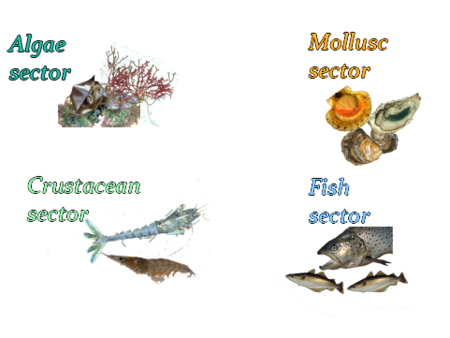Microphytes
| ||||||||||||||||||||||||||||||||||
Culture techniques and production cycle
The production of cells still follows relatively empirical ways; it consists essentially of discontinuous cultivation, either outdoor in tanks or ponds, or indoor in large plastic flasks. The erratic cultivation conditions generally induce major variations in the quantity of algae, which in turns leads to fluctuations in the growth of the animals which feed on them.
Cultivation periods last three to seven days, at the end of which the total production volume is fed to animals. In order to meet the nutritional needs of the animals, at least two different species of microalgae must be fed to them. In some hatcheries, the volumes concerned can reach up to hundred cubic meters per day.
Evolution of the production
Tests are in progress to produce algae within closed, continuous systems, in order to meet the nutritional quality requirements requested by the hatcheries. Finely tuned control of the cultivation parameters enables some of the cellular compounds (aminoacids, polyunsaturated fatty acid concentrations) to be stabilized or even set to precise levels. Compared with discontinuous cultivation – in which final concentrations rarely exceed one tenth of a gram per liter of sea water – continuous systems make it possible to obtain concentrations that are ten to twenty times higher.
Product value enhancement
Algae freshly fed to farmed animals - using pumps or gravity flow systems - are clearly the best source of food for molluscs farms. The use of frozen lumps did not give convincing results for the growth of bivalves, but gave better results as food for zooplankton, which in turn will be consumed by crustaceans or fish.
In fish farms, the continuous presence of microalgae has a beneficial effect on the growth and health of animals (green water phenomenon).
Phytoplankton figures
6 | number of phytoplankton hatcheries producing for bivalve spats necessary for cultivation; Grainocean (17), Satmar (50), Ferranges (85), Sodabo (85), Kerner hatchery (56) Tinduff hatchery (29). |
|---|---|
2 | minimum number of phytoplankton species to be fed to bivalves to meet their nutritional needs. |
10 à 20 | times higher : the concentration of microalgae in the continuous production systems with respect to that achieved in discontinuous systems. |
Strengths / Weaknesses
Strengths | Weaknesses |
|---|---|
|
|

